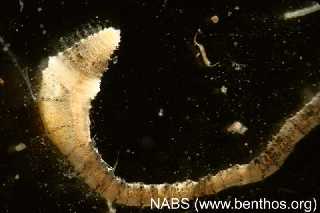Home → Water Quality → Monitoring & Reporting → Biomonitoring → Sampling & Analysis → Macroinvertebrate Types → Aquatic Earth Worms
 Aquatic Earth Worms (Oligochaeta)
Aquatic Earth Worms (Oligochaeta)
Aquatic earthworms closely resemble terrestrial earthworms. They have long, moderately muscular, cylindrical bodies composed of ring-like segments. Most aquatic earthworms range in length from 1-30mm long, although some may be as long as 150mm. The anterior (front) end of the worm has no suckers or eyespots. Aquatic earthworms are hermaphroditic and can reproduce sexually or asexually. Because these worms undergo no metamorphosis as they age, juveniles can only be distinguished from adults by their smaller relative size.
Aquatic earthworms are mostly collector/gatherers that burrow through the upper layer of soft, fine sediment grazing on bacteria, protozoa, algae, and dead organic matter. Others live in vertical mud tubes in the sediment, with their hind end protruding to absorb oxygen. Aquatic earthworms can absorb oxygen over their entire surface area. Many can enhance their oxygen consumption by absorbing oxygen through the digestive tract. Some worms have even more specialized adaptations to cope with low oxygen, such as gills or hemoglobin in their blood that helps transport oxygen and turns them bright red. Because aquatic earthworms can breathe in low oxygen conditions and eat detritus, they can be found in virtually all aquatic habitats.
Aquatic earthworms have an important influence on the bottom sediment where they live. Their feeding behavior mixes the sediment, keeping it aerated and providing oxygen for other organisms. They are a normal component of many healthy ecosystems, and tend to dominate habitats such as deep or stagnant waters that are naturally low in oxygen. Their high tolerance for low oxygen also means that they are able to survive in the anaerobic conditions caused by severe nutrient pollution, such as a sewage discharge, that kills off other invertebrates. An aquatic invertebrate community dominated by large red worms in an area that isn't naturally oxygen-deprived is often an indicator of organic pollution.
Picture key
Photo: An aquatic earth worm (Quistadrilus multisetosus)
Source: The North American Benthological Society
Bibliography
Voshell, Jr., J. Reese; illustrated by Amy Bartlett Wright. 2002. A Guide to Common Freshwater Invertebrates of North America. Blacksburg (VA): The McDonald & Woodward Publishing Company. 442 p